Formation of Ultramylonites in an Upper Mantle Shear Zone, Erro-Tobbio, Italy
Abstract
:1. Introduction
2. Geological Setting
3. Materials and Methods
4. Results
4.1. Sample Description
4.2. EBSD Data
4.2.1. Clinopyroxene
4.2.2. Orthopyroxene
4.2.3. Fine-Grained Layers
4.3. Chemical Composition and Geothermal Calculations
5. Discussion
5.1. Microstructural Evolution
5.2. Olivine-Rich Matrix
5.3. Strain Localization
Supplementary Materials
Author Contributions
Funding
Acknowledgments
Conflicts of Interest
References
- Bürgmann, R.; Dresen, G. Rheology of the Lower Crust and Upper Mantle: Evidence from Rock Mechanics, Geodesy, and Field Observations. Annu. Rev. Earth Planet. Sci. 2008, 36, 531–567. [Google Scholar] [CrossRef] [Green Version]
- Drury, M.R.; Vissers, R.L.M.; Wal, D.; Hoogerduijn Strating, E.H. Shear localisation in upper mantle peridotites. Pure Appl. Geophys. 1991, 137, 439–460. [Google Scholar] [CrossRef]
- Vissers, R.L.M.; Drury, M.R.; Hoogerduijn Strating, E.H.; Spiers, C.J.; van der Wal, D. Mantle shear zones and their effect on lithosphere strength during continental breakup. Tectonophysics 1995, 249, 155–171. [Google Scholar] [CrossRef]
- Bercovici, D. The generation of plate tectonics from mantle convection. Earth Planet. Sci. Lett. 2003, 205, 107–121. [Google Scholar] [CrossRef]
- Tackley, P.J. Mantle convection and plate tectonics: Toward an integrated physical and chemical theory. Science 2000, 288, 2002–2007. [Google Scholar] [CrossRef] [PubMed]
- Tommasi, A.; Vauchez, A. Heterogeneity and anisotropy in the lithospheric mantle. Tectonophysics 2015, 661, 11–37. [Google Scholar] [CrossRef]
- Mei, S.; Kohlstedt, D.L. Influence of water on plastic deformation of olivine aggregates 1. Diffusion creep regime. J. Geophys. Res. Solid Earth 2000, 105, 21457–21469. [Google Scholar] [CrossRef]
- Mei, S.; Kohlstedt, D.L. Influence of water on plastic deformation of olivine aggregates 2. Dislocation creep regime. J. Geophys. Res. Solid Earth 2000, 105, 21471–21481. [Google Scholar] [CrossRef]
- Tasaka, M.; Zimmerman, M.E.; Kohlstedt, D.L. Evolution of the rheological and microstructural properties of olivine aggregates during dislocation creep under hydrous conditions. J. Geophys. Res. Solid Earth 2015, 121, 92–113. [Google Scholar] [CrossRef] [Green Version]
- Hirth, G.; Kohlstedt, D.L. Experimental constraints on the dynamics of the partially molten upper mantle: 2. Deformation in the dislocation creep regime. J. Geophys. Res. 1995, 100, 15411–15449. [Google Scholar] [CrossRef]
- Hirth, G.; Kohlstedt, D.L. Experimental constraints on the dynamics of the partially molten upper mantle: Deformation in the diffusion creep regime. J. Geophys. Res. 1995, 100, 1981–2001. [Google Scholar] [CrossRef]
- Zimmerman, M.E.; Kohlstedt, D.L. Rheological Properties of Partially Molten Lherzolite. J. Petrol. 2004, 45, 275–298. [Google Scholar] [CrossRef] [Green Version]
- Hansen, L.N.; Zimmerman, M.E.; Kohlstedt, D.L. Grain boundary sliding in San Carlos olivine: Flow law parameters and crystallographic-preferred orientation. J. Geophys. Res. 2011, 116, 1–16. [Google Scholar] [CrossRef]
- Hirth, G.; Kohlstedt, D.L. Rheology of the upper mantle and the mantle wedge: A view from the experimentalists. In Inside the Subduction Factory; Eiler, J., Ed.; Geophysical Monograph; American Geophysical Union: Washington, DC, USA, 2003; Volume 138, pp. 83–105. [Google Scholar]
- Skemer, P.; Warren, J.M.; Hansen, L.N.; Hirth, G.; Kelemen, P.B. The influence of water and LPO on the initiation and evolution of mantle shear zones. Earth Planet. Sci. Lett. 2013, 375, 222–233. [Google Scholar] [CrossRef]
- Tommasi, A.; Knoll, M.; Vauchez, A.; Signorelli, J.W.; Thoraval, C.; Logé, R. Structural reactivation in plate tectonics controlled by olivine crystal anisotropy. Nat. Geosci. 2009, 2, 423–427. [Google Scholar] [CrossRef]
- Hansen, L.N.; Zimmerman, M.E.; Kohlstedt, D.L. Laboratory measurements of the viscous anisotropy of olivine aggregates. Nature 2012, 492, 415–418. [Google Scholar] [CrossRef]
- Dijkstra, A.H.; Drury, M.R.; Frijhoff, R.M. Microstructures and lattice fabrics in the Hilti mantle section (Oman Ophiolite): Evidence for shear localization and melt weakening in the crust–mantle transition zone? J. Geophys. Res. 2002, 107, 1–18. [Google Scholar] [CrossRef]
- Regenauer-Lieb, K.; Yuen, D. Positive feedback of interacting ductile faults from coupling of equation of state, rheology and thermal-mechanics. Phys. Earth Planet. Inter. 2004, 142, 113–135. [Google Scholar] [CrossRef]
- Matysiak, A.K.; Trepmann, C.A. Crystal-plastic deformation and recrystallization of peridotite controlled by the seismic cycle. Tectonophysics 2012, 530–531, 111–127. [Google Scholar] [CrossRef]
- Kelemen, P.B.; Hirth, G. A periodic shear-heating mechanism for intermediate-depth earthquakes in the mantle. Nature 2007, 446, 787–790. [Google Scholar] [CrossRef]
- Thielmann, M.; Rozel, A.; Kaus, B.J.P.; Ricard, Y. Intermediate-depth earthquake generation and shear zone formation caused by grain size reduction and shear heating. Geology 2015, 43, 791–794. [Google Scholar] [CrossRef]
- Evans, B.; Renner, J.; Hirth, G. A few remarks on the kinetics of static grain growth in rocks. Int. J. Earth Sci. 2001, 90, 88–103. [Google Scholar] [CrossRef]
- Drury, M.R.; Urai, J.L. Deformation-related recrystallization processes. Tectonophysics 1990, 172, 235–253. [Google Scholar] [CrossRef]
- Karato, S. Grain growth kinetics in olivine aggregates. Tectonophysics 1989, 168, 255–273. [Google Scholar] [CrossRef]
- Bystricky, M.; Kunze, K.; Burlini, L.; Burg, J.-P. High Shear Strain of Olivine Aggregates: Rheological and Seismic Consequences. Science 2000, 290, 1564–1567. [Google Scholar] [CrossRef] [Green Version]
- Newman, J.; Lamb, W.M.; Drury, M.R.; Vissers, R.L.M. Deformation processes in a peridotite shear zone: Reaction-softening by an H2O-deficient, continuous net transfer reaction. Tectonophysics 1999, 303, 193–222. [Google Scholar] [CrossRef]
- Linckens, J.; Herwegh, M.; Müntener, O.; Mercolli, I. Evolution of a polymineralic mantle shear zone and the role of second phases in the localization of deformation. J. Geophys. Res. 2011, 116, 1–21. [Google Scholar] [CrossRef]
- Handy, M. Flow laws for rocks containing two non-linear viscous phases: A phenomenological approach. J. Struct. Geol. 1994, 16, 287–301. [Google Scholar] [CrossRef]
- Ji, S.; Zhao, P.; Xia, B. Flow laws of multiphase materials and rocks from end-member flow laws. Tectonophysics 2003, 370, 129–145. [Google Scholar] [CrossRef]
- Tasaka, M.; Hiraga, T.; Zimmerman, M.E. Influence of mineral fraction on the rheological properties of forsterite + enstatite during grain-size-sensitive creep: 2. Deformation experiments. J. Geophys. Res. Solid Earth 2013, 118, 3991–4012. [Google Scholar] [CrossRef]
- Fusseis, F.; Regenauer-Lieb, K.; Liu, J.; Hough, R.M.; De Carlo, F. Creep cavitation can establish a dynamic granular fluid pump in ductile shear zones. Nature 2009, 459, 974–977. [Google Scholar] [CrossRef] [PubMed]
- Précigout, J.; Prigent, C.; Palasse, L.; Pochon, A. Water pumping in mantle shear zones. Nat. Commun. 2017, 8. [Google Scholar] [CrossRef] [PubMed]
- Précigout, J.; Stünitz, H.; Villeneuve, J. Excess water storage induced by viscous strain localization during high-pressure shear experiment. Sci. Rep. 2019, 9. [Google Scholar] [CrossRef] [PubMed] [Green Version]
- Downes, H. Shear zones in the upper mantle − Relation between geochemical enrichment and deformation in mantle peridotites. Geology 1990, 18, 374–377. [Google Scholar] [CrossRef]
- Hidas, K.; Tommasi, A.; Garrido, C.J.; Padrón-navarta, J.A.; Mainprice, D. Fluid-assisted strain localization in peridotites during emplacement of the shallow subcontinental lithospheric mantle. Lithos 2016, 262, 636–650. [Google Scholar] [CrossRef]
- Kaczmarek, M.-A.; Müntener, O. Juxtaposition of melt impregnation and high-temperature shear zones in the upper mantle; field and petrological constraints from the Lanzo peridotite (Northern Italy). J. Petrol. 2008, 49, 2187–2220. [Google Scholar] [CrossRef]
- Mei, S.; Bai, W.; Hiraga, T.; Kohlstedt, D.L. Influence of melt on the creep behavior of olivine-basalt aggregates under hydrous conditions. Earth Planet. Sci. Lett. 2002, 201, 491–507. [Google Scholar] [CrossRef]
- Holtzman, B.K.; Kohlstedt, D.L.; Zimmerman, M.E.; Heidelbach, F.; Hiraga, T.; Hustoft, J. Melt segregation and strain partitioning: Implications for seismic anisotropy and mantle flow. Science 2003, 301, 1227–1230. [Google Scholar] [CrossRef] [Green Version]
- Dijkstra, A.H.; Drury, M.R.; Vissers, R.L.M.; Newman, J. On the role of melt-rock reaction in mantle shear zone formation in the Othris Peridotite Massif (Greece). J. Struct. Geol. 2002, 24, 1431–1450. [Google Scholar] [CrossRef]
- Hoogerduijn Strating, E.; Rampone, E.; Piccardo, G.; Drury, M.R.; Vissers, R.L. Subsolidus emplacement of mantle peridotites during incipient oceanic rifting and opening of the Mesozoic Tethys (Voltri Massif, NW Italy). J. Petrol. 1993, 34, 901–927. [Google Scholar] [CrossRef]
- Urai, J.L.; Spiers, C.J.; Zwart, H.J.; Lister, G.S. Weakening of rock salt by water during long-term creep. Nature 1986, 324, 554–557. [Google Scholar] [CrossRef] [PubMed]
- Van der Wal, D.; Chopra, P.; Drury, M.R.; Fitz Gerald, J.D. Relationships between dynamically recrystallized grain size and deformation conditions in experimentally deformed olivine rocks. Geophys. Res. Lett. 1993, 20, 1479–1482. [Google Scholar] [CrossRef]
- Précigout, J.; Gueydan, F. Mantle weakening and strain localization: Implications for the long-term strength of the continental lithosphere. Geology 2009, 37, 147–150. [Google Scholar] [CrossRef] [Green Version]
- Précigout, J.; Gueydan, F.; Gapais, D.; Garrido, C.; Essaifi, A. Strain localisation in the subcontinental mantle—A ductile alternative to the brittle mantle. Tectonophysics 2007, 445, 318–336. [Google Scholar] [CrossRef]
- Hansen, L.N.; Warren, J.M. Quantifying the effect of pyroxene on deformation of peridotite in a natural shear zone. J. Geophys. Res. B Solid Earth 2015, 120, 2717–2738. [Google Scholar] [CrossRef] [Green Version]
- Linckens, J.; Herwegh, M.; Müntener, O. Small quantity but large effect—How minor phases control strain localization in upper mantle shear zones. Tectonophysics 2015, 643, 26–43. [Google Scholar] [CrossRef]
- Jaroslow, G.E.; Hirth, G.; Dick, H.J.B. Abyssal peridotite mylonites: Implications for grain-size sensitive flow and strain localization in the oceanic lithosphere. Tectonophysics 1996, 256, 17–37. [Google Scholar] [CrossRef]
- Platt, J.P. Rheology of two-phase systems: A microphysical and observational approach. J. Struct. Geol. 2015, 77, 213–227. [Google Scholar] [CrossRef] [Green Version]
- Skemer, P.; Warren, J.M.; Kelemen, P.B.; Hirth, G. Microstructural and rheological evolution of a mantle shear zone. J. Petrol. 2010, 51, 43–53. [Google Scholar] [CrossRef] [Green Version]
- Warren, J.M.; Hirth, G. Grain size sensitive deformation mechanisms in naturally deformed peridotites. Earth Planet. Sci. Lett. 2006, 248, 438–450. [Google Scholar] [CrossRef]
- Tasaka, M.; Hiraga, T. Influence of mineral fraction on the rheological properties of forsterite + enstatite during grain-size-sensitive creep: 1. Grain size and grain growth laws. J. Geophys. Res. Solid Earth 2013, 118, 3970–3990. [Google Scholar] [CrossRef]
- Bercovici, D.; Ricard, Y. Generation of plate tectonics with two-phase grain-damage and pinning: Source-sink model and toroidal flow. Earth Planet. Sci. Lett. 2013, 365, 275–288. [Google Scholar] [CrossRef]
- Bercovici, D.; Ricard, Y. Plate tectonics, damage and inheritance. Nature 2014, 508, 513–516. [Google Scholar] [CrossRef] [PubMed]
- Précigout, J.; Stünitz, H. Evidence of phase nucleation during olivine diffusion creep: A new perspective for mantle strain localisation. Earth Planet. Sci. Lett. 2016, 455, 94–105. [Google Scholar] [CrossRef] [Green Version]
- Ashby, M.F.; Verrall, R.A. Diffusion-accommodated flow and superplasticity. Acta Metall. 1973, 21, 149–163. [Google Scholar] [CrossRef]
- Farla, R.J.M.; Karato, S.-I.; Cai, Z. Role of orthopyroxene in rheological weakening of the lithosphere via dynamic recrystallization. Proc. Natl. Acad. Sci. USA 2013, 110, 16355–16360. [Google Scholar] [CrossRef] [Green Version]
- Linckens, J.; Bruijn, R.H.C.; Skemer, P. Dynamic recrystallization and phase mixing in experimentally deformed peridotite. Earth Planet. Sci. Lett. 2014, 388, 134–142. [Google Scholar] [CrossRef]
- Rampone, E.; Romairone, A.; Abouchami, W.; Piccardo, G.B.; Hofmann, A.W. Chronology, petrology and isotope geochemistry of the Erro-Tobbio peridotites (Ligurian Alps, Italy): Records of Late Palaeozoic lithospheric extension. J. Petrol. 2005, 46, 799–827. [Google Scholar] [CrossRef] [Green Version]
- Piccardo, G.B.; Padovano, M.; Guarnieri, L. The Ligurian Tethys: Mantle processes and geodynamics. Earth-Sci. Rev. 2014, 138, 409–434. [Google Scholar] [CrossRef]
- Padovano, M.; Piccardo, G.B.; Vissers, R.L.M. Tectonic and magmatic evolution of the mantle lithosphere during the rifting stages of a fossil slow—Ultraslow spreading basin: Insights from the Erro–Tobbio peridotite (Voltri Massif, NW Italy). Geol. Soc. 2014, 413, 205–238. [Google Scholar] [CrossRef]
- Piccardo, G.B.; Vissers, R.L.M. The pre-oceanic evolution of the Erro-Tobbio peridotite (Voltri Massif, Ligurian Alps, Italy). J. Geodyn. 2007, 43, 417–449. [Google Scholar] [CrossRef]
- Piccardo, G.B. Subduction of a fossil slow-ultraslow spreading ocean: A petrology-constrained geodynamic model based on the Voltri Massif, Ligurian Alps, Northwest Italy. Int. Geol. Rev. 2013, 55, 787–803. [Google Scholar] [CrossRef]
- Bunge, H.-J. Texture Analysis in Materials Science; Butterworths: London, UK, 1982. [Google Scholar]
- Skemer, P.; Katayama, I.; Jiang, Z.; Karato, S. The misorientation index: Development of a new method for calculating the strength of lattice-preferred orientation. Tectonophysics 2005, 411, 157–167. [Google Scholar] [CrossRef]
- Brey, G.P.; Koehler, T. Geothermobarometry in four-phase lherzolites II. New thermobarometers, and practical assessment of existing thermobarometers. J. Petrol. 1990, 31, 1353–1378. [Google Scholar] [CrossRef]
- Witt-Eickschen, G.; Seck, H.A. Solubility of Ca and Al in orthopyroxene from spinel peridotite: An improved version of an empirical geothermometer. Contrib. to Mineral. Petrol. 1991, 106, 431–439. [Google Scholar] [CrossRef]
- Karato, S.; Jung, H.; Katayama, I.; Skemer, P. Geodynamic significance of seismic anisotropy of the upper mantle: New insights from laboratory studies. Annu. Rev. Earth Planet. Sci. 2008, 36, 59–95. [Google Scholar] [CrossRef] [Green Version]
- Jung, H.; Karato, S. Water-induced fabric transitions in olivine. Science 2001, 293, 1460–1463. [Google Scholar] [CrossRef] [PubMed] [Green Version]
- Tommasi, A.; Vauchez, A.; Godard, M.; Belley, F. Deformation and melt transport in a highly depleted peridotite massif from the Canadian Cordillera: Implications to seismic anisotropy above subduction zones. Earth Planet. Sci. Lett. 2006, 252, 245–259. [Google Scholar] [CrossRef]
- Park, M.; Jung, H. Microstructural evolution of the Yugu peridotites in the Gyeonggi Massif, Korea: Implications for olivine fabric transition in mantle shear zones. Tectonophysics 2017, 709, 55–68. [Google Scholar] [CrossRef]
- Kumamoto, K.M.; Warren, J.M.; Hansen, L.N. Evolution of the Josephine Peridotite Shear Zones: 2. Influences on Olivine Cpo Evolution. J. Geophys. Res. Solid Earth 2019, 124, 12763–12781. [Google Scholar] [CrossRef]
- Bernard, R.E.; Behr, W.M.; Becker, T.W.; Young, D.J. Relationships Between Olivine CPO and Deformation Parameters in Naturally Deformed Rocks and Implications for Mantle Seismic Anisotropy. Geochem. Geophys. Geosystems 2019, 20, 3469–3494. [Google Scholar] [CrossRef] [Green Version]
- Tommasi, A.; Langone, A.; Padrón-Navarta, J.A.; Zanetti, A.; Vauchez, A. Hydrous melts weaken the mantle, crystallization of pargasite and phlogopite does not: Insights from a petrostructural study of the Finero peridotites, southern Alps. Earth Planet. Sci. Lett. 2017, 477, 59–72. [Google Scholar] [CrossRef]
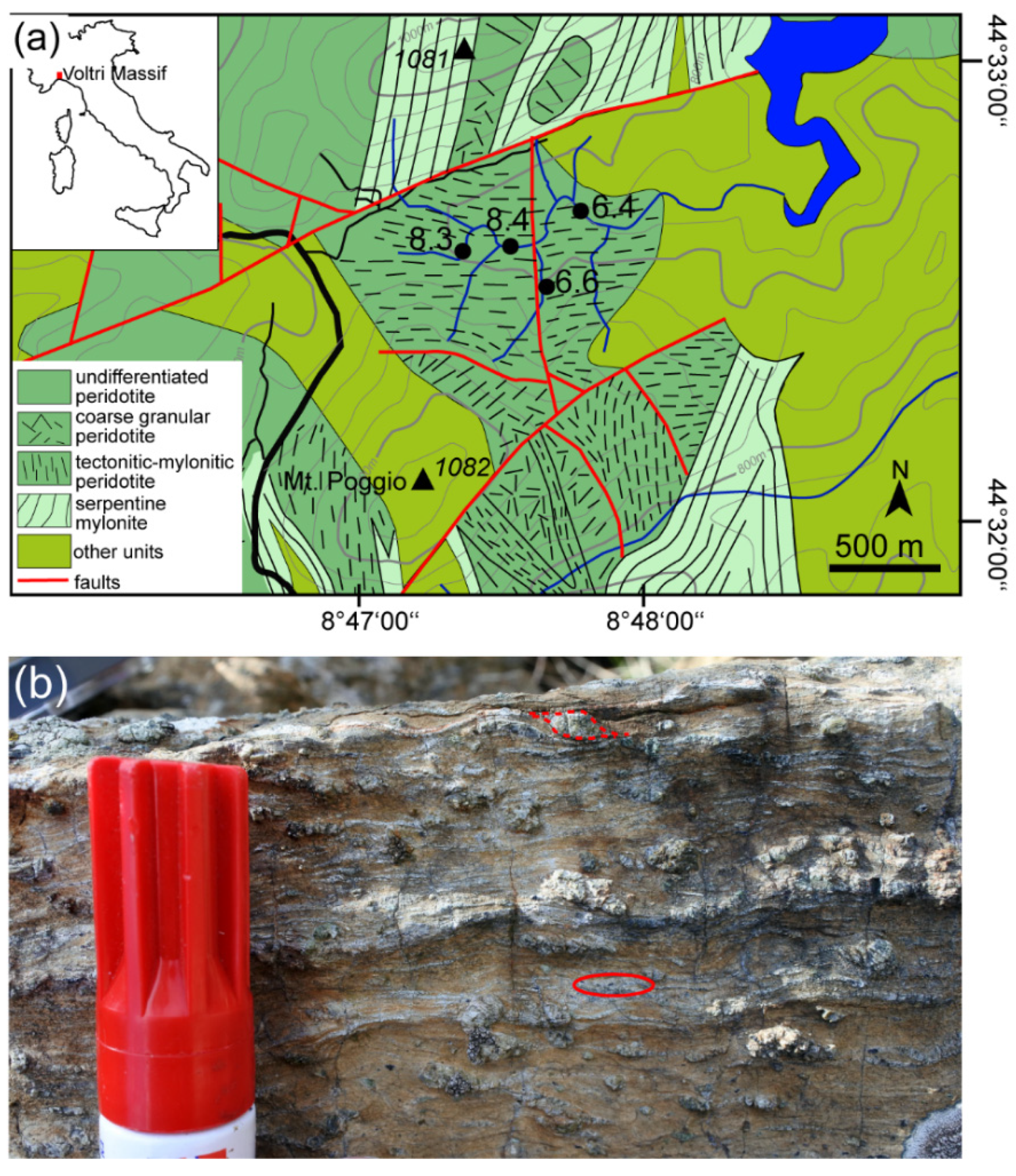
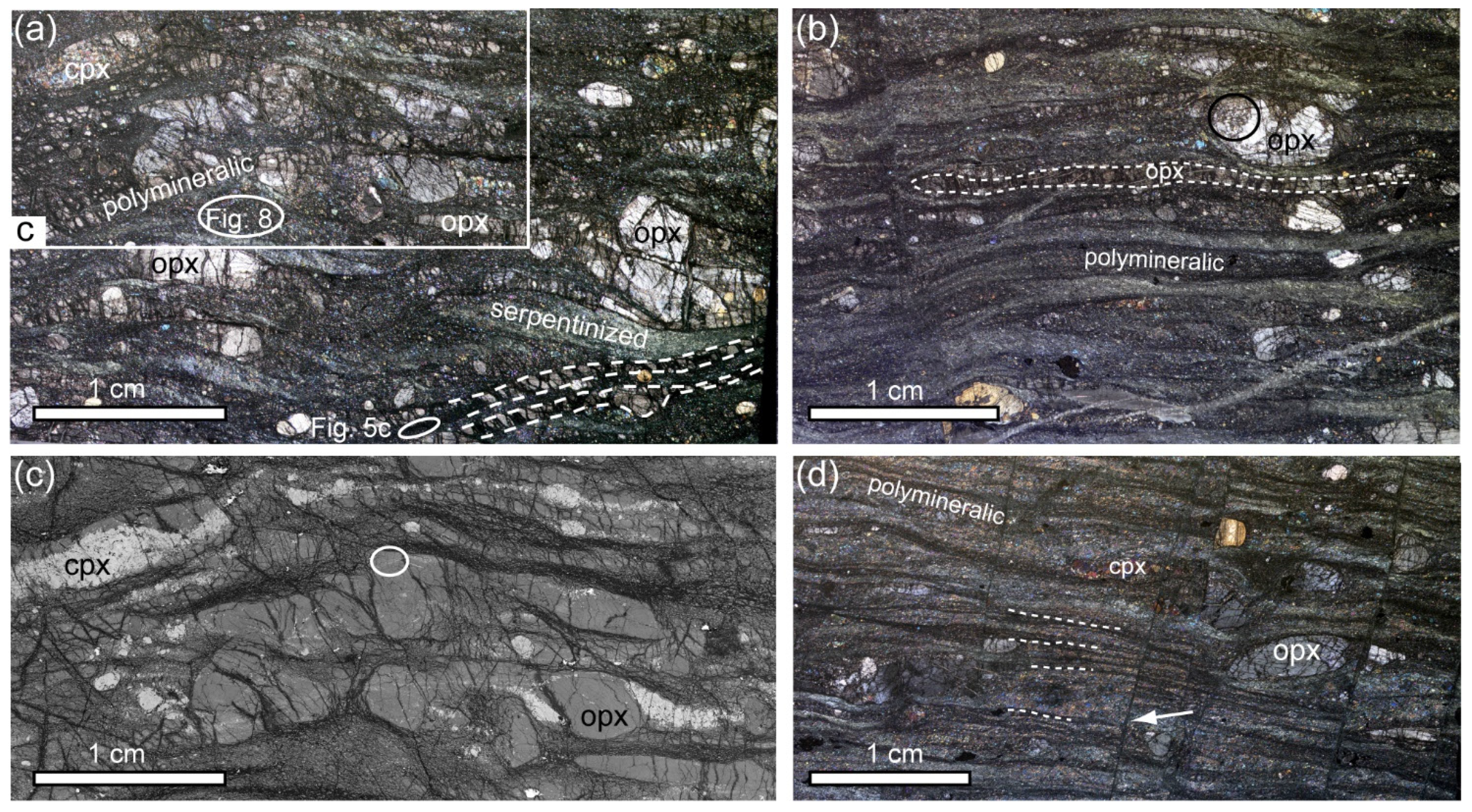

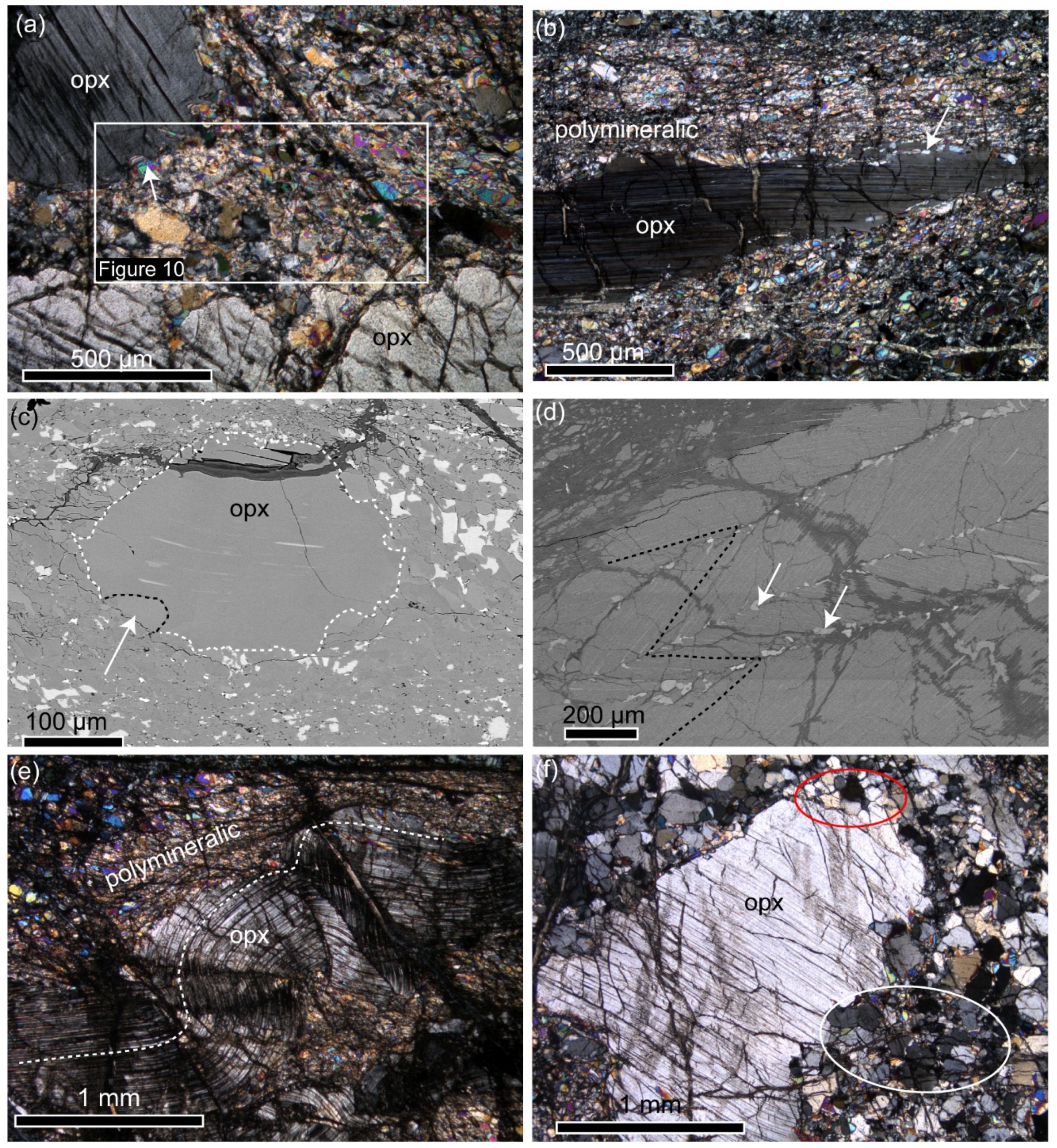
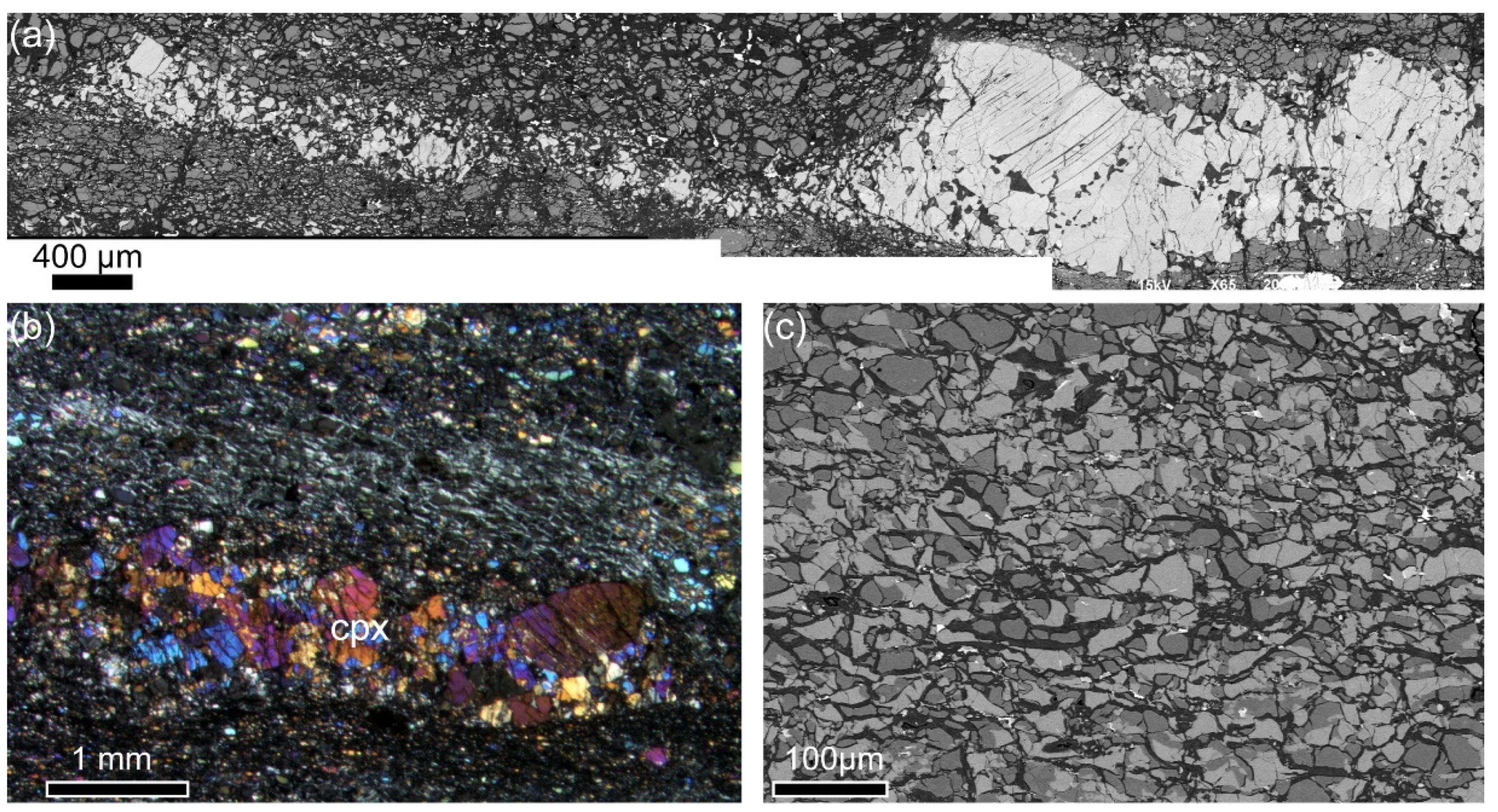


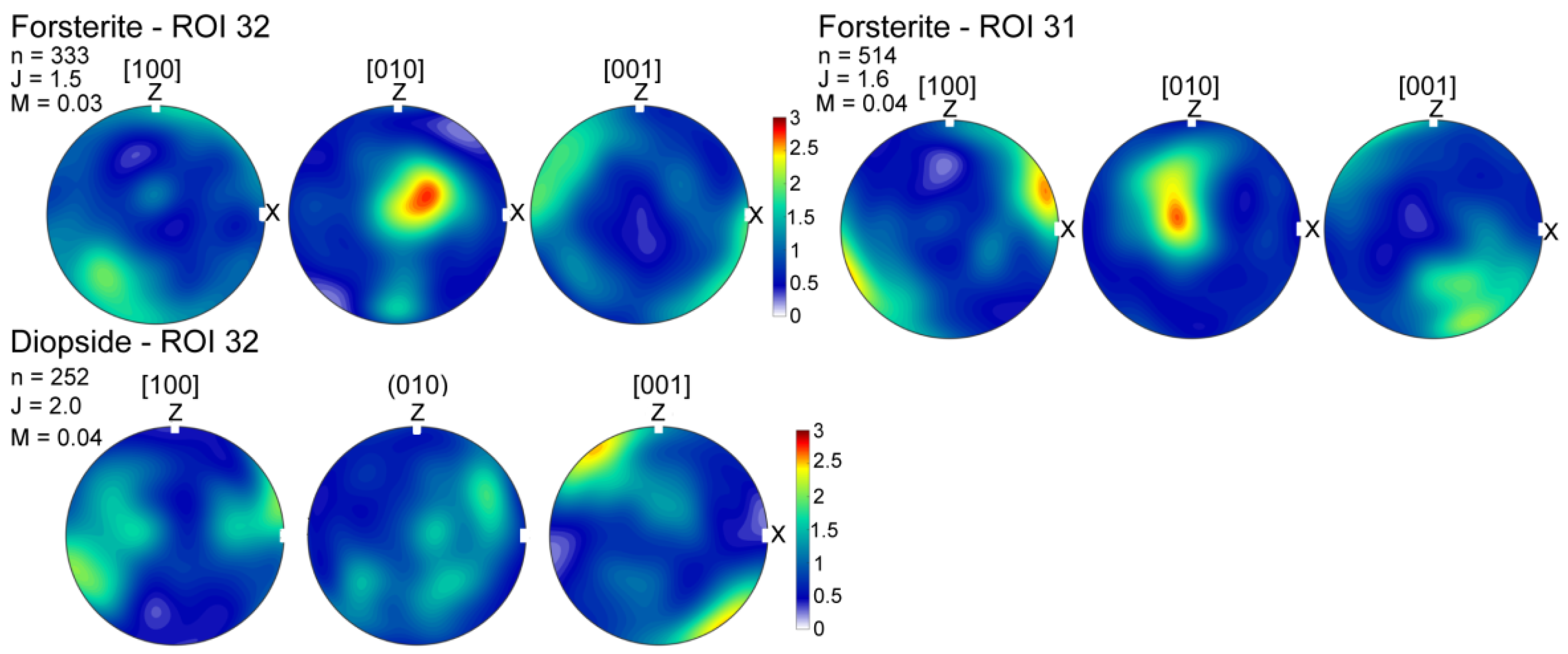
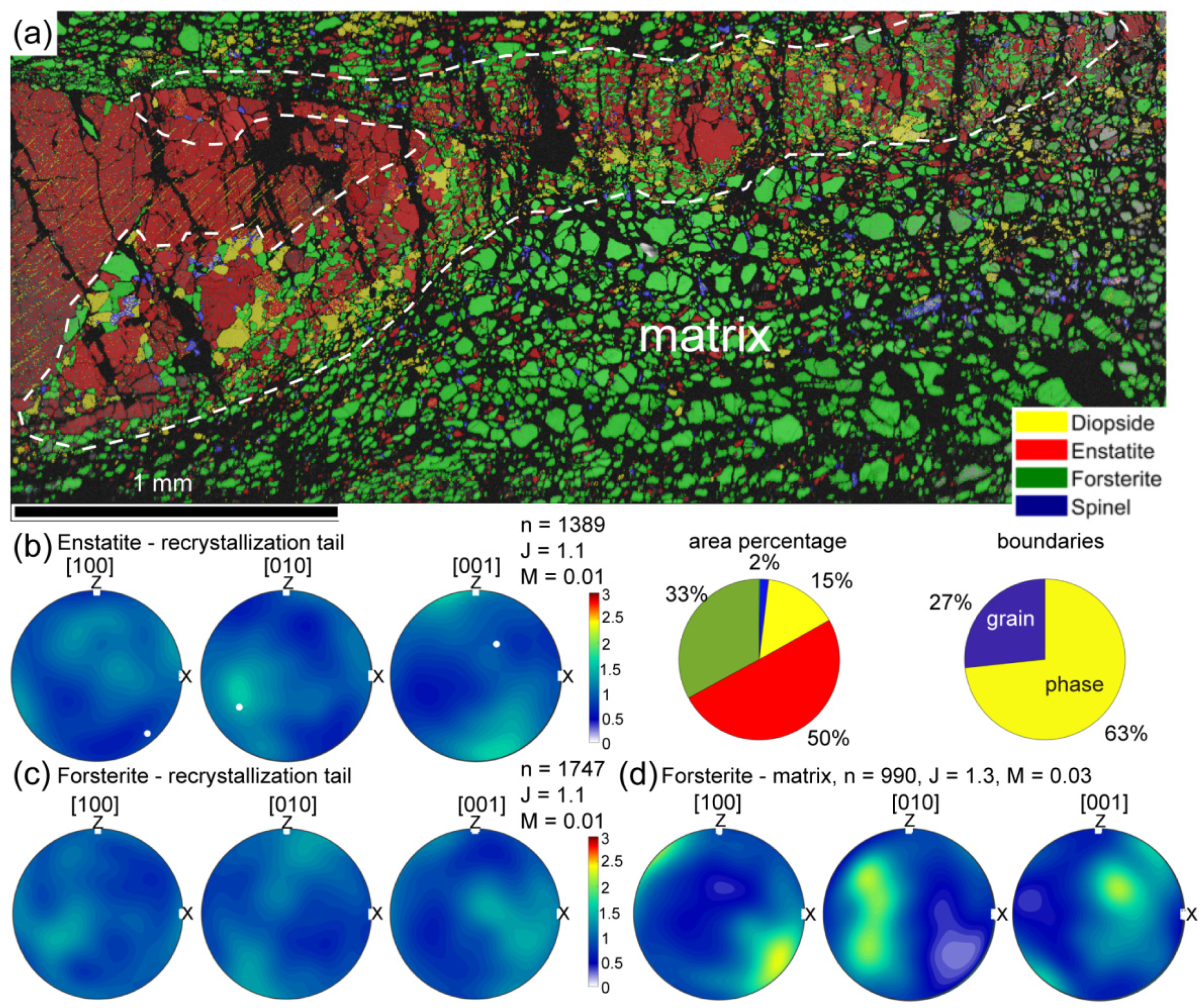
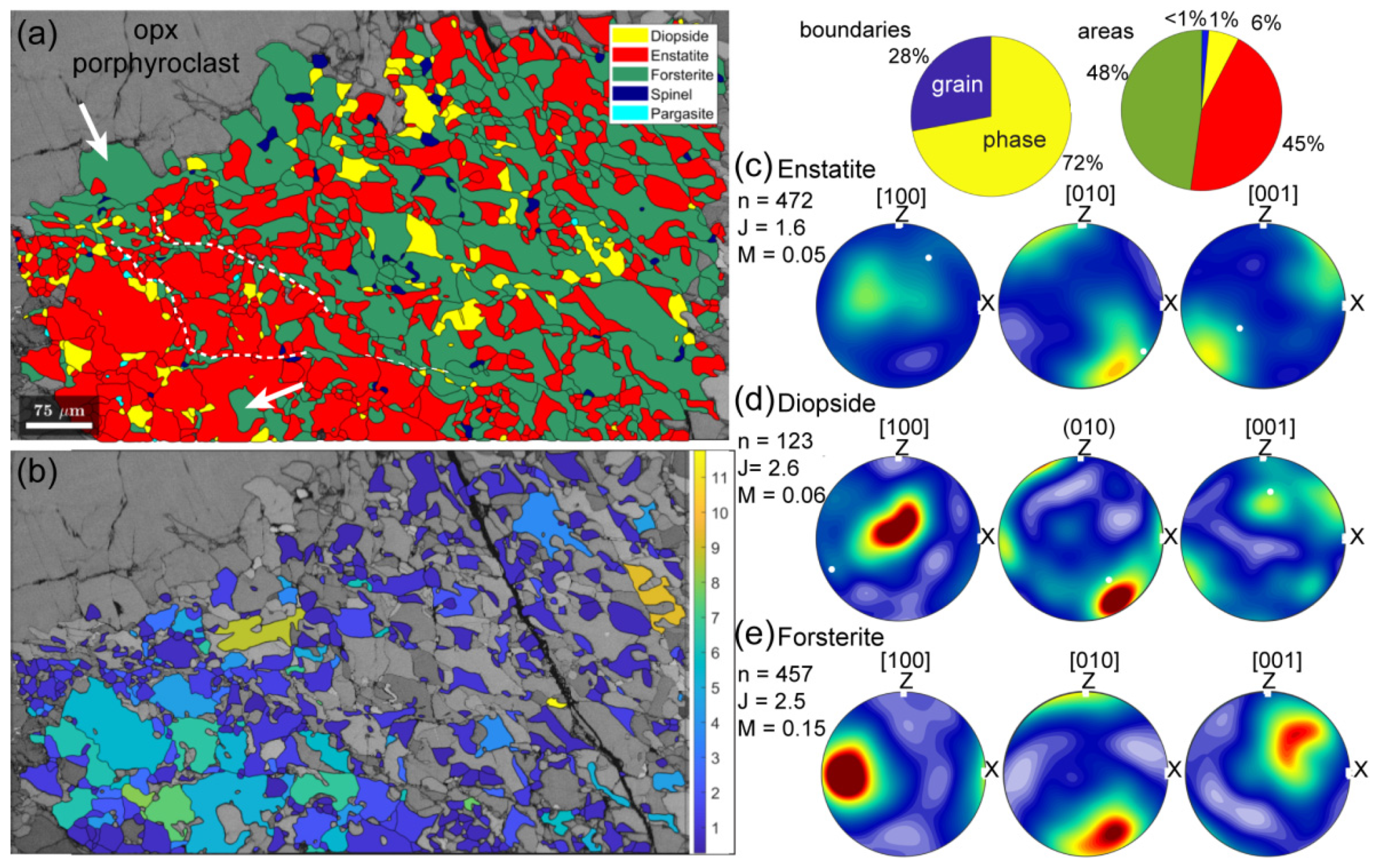

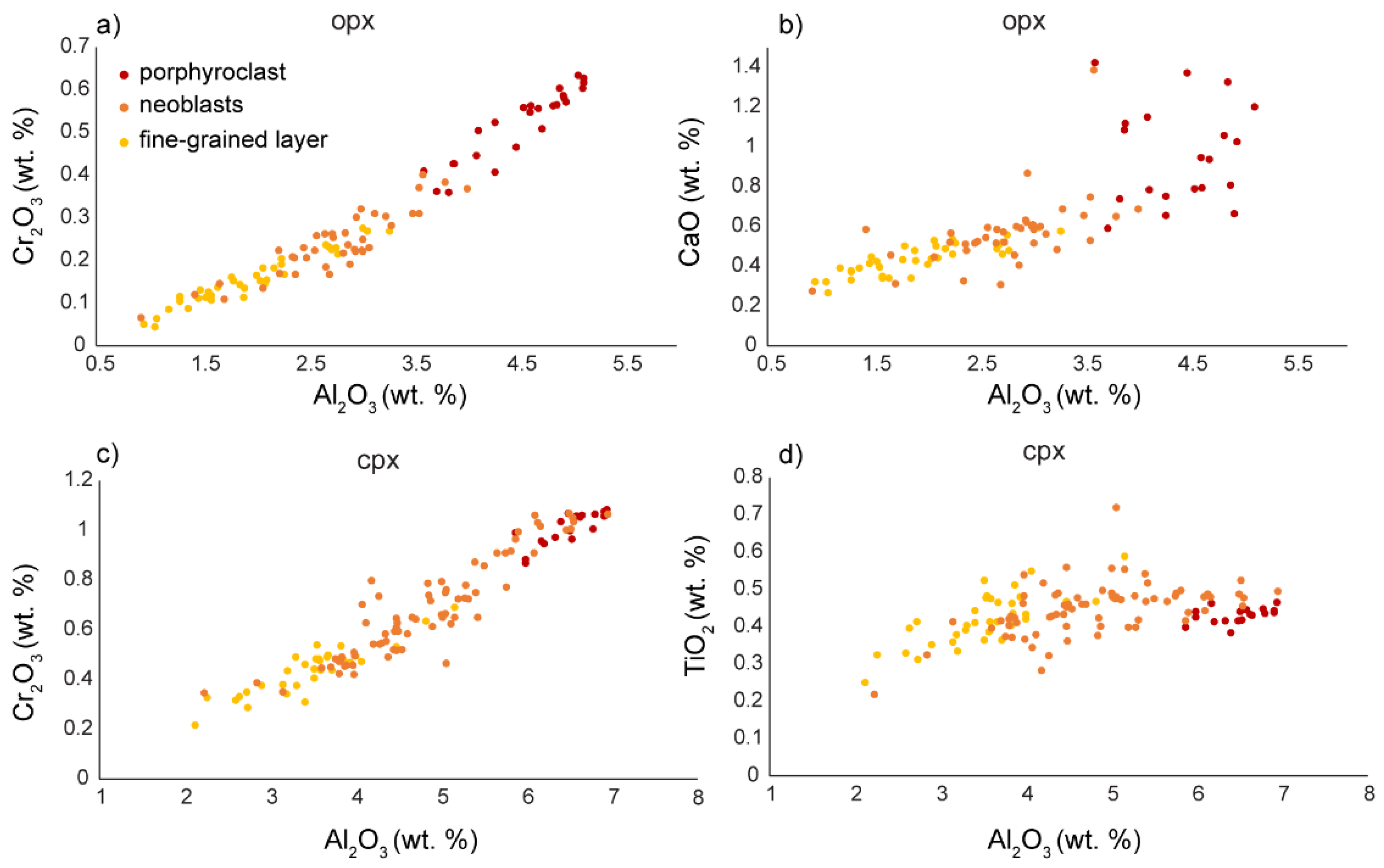


| Map Name | Type | Olivine | Opx | Cpx | Spinel | Pargasite | PB | |||||
|---|---|---|---|---|---|---|---|---|---|---|---|---|
| Area | Grain Size | Area | Grain Size | Area | Grain Size | Area | Grain Size | Area | Grain Size | |||
| ROI 12 | cpx rxs | 5 | 15 ± 7 | 4 | 19 ± 12 | 87 | 30 ± 41 | 5 | 18 ± 20 | 47 | ||
| ROI 16 | cpx rxs | 4 | 18 ± 11 | <1 | 18 ± 8 | 95 | 36 ± 42 | <1 | 16 ± 6 | 25 | ||
| ROI 33 | cpx rxs with ol | 33 | 10 ± 6 | 1 | 66 | 11 ± 9 | <1 | 63 | ||||
| ROI 32 | olivine + cpx | 58 | 16 ± 8 | 3 | 12 ± 4 | 37 | 15 ± 7 | 3 | 9 ± 4 | 64 | ||
| ROI 20 | small opx rxs | 48 | 16 ± 12 | 45 | 15 ± 12 | 6 | 12 ± 8 | 1 | 9 ± 3 | 72 | ||
| ROI 24 | small opx rxs | 66 | 12 ± 8 | 32 | 12 ± 10 | 1 | 8 ± 3 | 61 | ||||
| ROI 25 | large opx rxs | 33 | 14 ± 8 | 50 | 17 ± 15 | 15 | 15 ± 11 | 2 | 10 ± 5 | 73 | ||
| ROI 25 | Olivine | 88 | 45 ± 30 | 7 | 27 ± 11 | 3 | 28 ± 10 | 2 | 27 ± 10 | 45 | ||
| ROI 31 | Olivine | 73 | 23 ± 16 | 15 | 17 ± 9 | 9 | 17 ± 9 | 2 | 10 ± 5 | 68 | ||
| ROI 13 | Ultramylonite | 62 | 12 ± 7 | 29 | 12 ± 7 | 9 | 11 ± 5 | 67 | ||||
| ROI 14 | Ultramylonite | 76 | 5 ± 4 | 16 | 4 ± 3 | 6 | 4 ± 2 | 1 | 3 ± 1 | <1 | 52 | |
| ROI 19 | Ultramylonite | 51 | 11 ± 7 | 39 | 10 ± 8 | 7 | 9 ± 5 | 3 | 8 ± 9 | <1 | 7 ± 2 | 66 |
| ROI 23 | Ultramylonite | 75 | 9 ± 6 | 21 | 8 ± 4 | 4 | 7 ± 4 | 52 | ||||
| n | TCa-in-opx | TAl-Cr-in-opx | n | T2-pyx | |
|---|---|---|---|---|---|
| porphyroclasts | 4 (24) | 1059 ± 95 | 1022 ± 47 | ||
| neoblasts | 6 (50) | 884 ± 58 | 823 ± 59 | 6 (19) | 853 ± 32 |
| fine-grained | 6 (29) | 846 ± 38 | 775 ± 48 | 5 (14) | 843 ± 30 |
Publisher’s Note: MDPI stays neutral with regard to jurisdictional claims in published maps and institutional affiliations. |
© 2021 by the authors. Licensee MDPI, Basel, Switzerland. This article is an open access article distributed under the terms and conditions of the Creative Commons Attribution (CC BY) license (https://creativecommons.org/licenses/by/4.0/).
Share and Cite
Linckens, J.; Tholen, S. Formation of Ultramylonites in an Upper Mantle Shear Zone, Erro-Tobbio, Italy. Minerals 2021, 11, 1036. https://doi.org/10.3390/min11101036
Linckens J, Tholen S. Formation of Ultramylonites in an Upper Mantle Shear Zone, Erro-Tobbio, Italy. Minerals. 2021; 11(10):1036. https://doi.org/10.3390/min11101036
Chicago/Turabian StyleLinckens, Jolien, and Sören Tholen. 2021. "Formation of Ultramylonites in an Upper Mantle Shear Zone, Erro-Tobbio, Italy" Minerals 11, no. 10: 1036. https://doi.org/10.3390/min11101036
APA StyleLinckens, J., & Tholen, S. (2021). Formation of Ultramylonites in an Upper Mantle Shear Zone, Erro-Tobbio, Italy. Minerals, 11(10), 1036. https://doi.org/10.3390/min11101036





